



There’s some good ones – and a few stranger ones, in this week’s mix, including glittery and glitzy starring stints for Pluto, Droopy, and Warner’s Three Bears, typical battles for Sylvester and Tom and Jerry, a strange UPA one-shot, and the entire screen history of a small pachyderm whom Terrytoons hoped would be a star, but who remains forgotten in the pages of time.
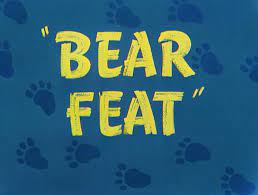 Bear Feat (Warner, Three Bears, 12/10/49 – Charles M. (Chuck) Jones, dir.) – The plot is basically a remake of Max Fleischer’s Popeye episode “Puttin’ On the Act”, as Papa Bear reads a want ad in a newspaper for a trick bear act, posted by the Mingling Brothers Circus. Mama Bear seems to know something about the ad, and keeps trying to interrupt Papa with her usual “But, Henry…”, but her words only fall on deaf ears. Junior Bear (the oversized lummox of the family) gets into the spirit of things by lying on his back and dizzily twirling Papa atop his feet, while vocally performing a circus march. Even Mama gets swept into circus fever, changing into gaudy attire and fake blonde curls, joining in the song, and catching the tumbling Papa on the tip of one finger. Papa reacts in his typical violent fashion, swinging a haymaker at Mama that misses entirely, and delivering a kick in the pants to Junior that scores its mark easily.
Bear Feat (Warner, Three Bears, 12/10/49 – Charles M. (Chuck) Jones, dir.) – The plot is basically a remake of Max Fleischer’s Popeye episode “Puttin’ On the Act”, as Papa Bear reads a want ad in a newspaper for a trick bear act, posted by the Mingling Brothers Circus. Mama Bear seems to know something about the ad, and keeps trying to interrupt Papa with her usual “But, Henry…”, but her words only fall on deaf ears. Junior Bear (the oversized lummox of the family) gets into the spirit of things by lying on his back and dizzily twirling Papa atop his feet, while vocally performing a circus march. Even Mama gets swept into circus fever, changing into gaudy attire and fake blonde curls, joining in the song, and catching the tumbling Papa on the tip of one finger. Papa reacts in his typical violent fashion, swinging a haymaker at Mama that misses entirely, and delivering a kick in the pants to Junior that scores its mark easily.
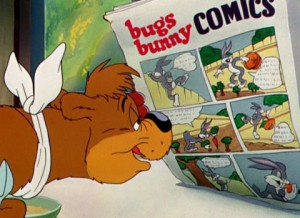 The bears string a wire between two tall trees. Papa, in a clown outfit, rides onto the wire with a unicycle from one end, while Junior does the same from the other side. They meet in the middle – but Junior’s weight has stretched the wire all the way to the ground. “Get off the wire”, orders Papa. Junior complies, the wire instantly launching Papa skyward once Junior’s weight is removed. Papa somersaults through the air for a half-mile, then lands in the chimney of their home. He emerges in a daze from the fireplace, blackened with soot, and swings another haymaker at Junior that misses, then falls off his unicycle, flat on his face. A trapeze act has similar results, stretching the trapeze ropes when Junior and Papa meet, then snapping back when Junior lets go, to bop Papa headfirst into the branch on which the trapeze is tied. Next, Mama holds up a large paper hoop, as Papa attempts to charge toward it at full speed on roller skates. Junior just happens to be emerging from the house after retrieving a snack, and sees the hoop from the backside. At full run, he also charges the hoop. Junior and Papa meet in opposite directions at the hoop rim, producing a shower of stars from their head-first collision. Papa briefly seeks retaliation, by placing Junior in a homemade “African dodger” booth to have baseballs thrown at his head for 5 cents. Papa is the booth’s first, and only, customer, pitching a ball that hits Junior’s skull dead-on, but produces no damage, instead rebounding the ball backwards for a direct hit upon Papa’s noggin.
The bears string a wire between two tall trees. Papa, in a clown outfit, rides onto the wire with a unicycle from one end, while Junior does the same from the other side. They meet in the middle – but Junior’s weight has stretched the wire all the way to the ground. “Get off the wire”, orders Papa. Junior complies, the wire instantly launching Papa skyward once Junior’s weight is removed. Papa somersaults through the air for a half-mile, then lands in the chimney of their home. He emerges in a daze from the fireplace, blackened with soot, and swings another haymaker at Junior that misses, then falls off his unicycle, flat on his face. A trapeze act has similar results, stretching the trapeze ropes when Junior and Papa meet, then snapping back when Junior lets go, to bop Papa headfirst into the branch on which the trapeze is tied. Next, Mama holds up a large paper hoop, as Papa attempts to charge toward it at full speed on roller skates. Junior just happens to be emerging from the house after retrieving a snack, and sees the hoop from the backside. At full run, he also charges the hoop. Junior and Papa meet in opposite directions at the hoop rim, producing a shower of stars from their head-first collision. Papa briefly seeks retaliation, by placing Junior in a homemade “African dodger” booth to have baseballs thrown at his head for 5 cents. Papa is the booth’s first, and only, customer, pitching a ball that hits Junior’s skull dead-on, but produces no damage, instead rebounding the ball backwards for a direct hit upon Papa’s noggin.
 An acrobatic act has Papa on one end of a teeter-totter, Junior atop a ladder, and Mama holding an easy chair above her head behind Papa to catch him. Junior jumps onto the other end of the teeter-totter. But instead of performing a graceful arc into the chair, Papa rises – and rises – and rises from the impact of Junior’s jump. Junior has to pull out a pair of binoculars to try to keep sight of Papa, then gives up as Papa is lost from view. Junior and Mama exchange looks of resignation that this is going to take a while, and slowly trudge their way back home, bedding down for the night, and slowly emerging at daybreak, to resume their position with the easy chair in the woods. Finally, the approaching sound of a descending slide whistle is heard, and Papa enters the frame – missing the chair entirely, and crashing into the ground.
An acrobatic act has Papa on one end of a teeter-totter, Junior atop a ladder, and Mama holding an easy chair above her head behind Papa to catch him. Junior jumps onto the other end of the teeter-totter. But instead of performing a graceful arc into the chair, Papa rises – and rises – and rises from the impact of Junior’s jump. Junior has to pull out a pair of binoculars to try to keep sight of Papa, then gives up as Papa is lost from view. Junior and Mama exchange looks of resignation that this is going to take a while, and slowly trudge their way back home, bedding down for the night, and slowly emerging at daybreak, to resume their position with the easy chair in the woods. Finally, the approaching sound of a descending slide whistle is heard, and Papa enters the frame – missing the chair entirely, and crashing into the ground.
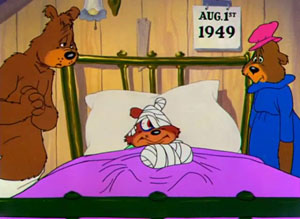 Papa attempts a high dive into a water tank. Junior has just eaten a large box of salted popcorn, and drains the tank dry with one slurp of thirst. A split-second after Junior finishes his drink, Papa hits the empty tank floor with a thud. Junior hollers to Mama, to see if she remembers the number of their local physician. Finally, Papa is seen inside a large, high-walled wooden tank serving as a circular track, seated astride a motorcycle. Papa aims to ride the walls of the tank at high speed – a feat he is sure will make them the top act in the business. Mama gives Papa the checkered flag to commence racing, and Papa zooms round and round while Mama’s eyes follow his progress dizzily. Junior’s appetite is at it again, and he passes the tank while finishing off a banana, carelessly tossing the peel into the tank. With a screech of brakes and a skid, disaster again hits Papa, leaving him to be found in the next shot in partial traction. Nevertheless, Papa is convinced they’re as ready as they’ll ever be, and calls for Mama to bring the newspaper again so he can check the circus’s address. To his shock, he takes note of a date printed at the top of the want ads page – April 16th, 1928. (Like the similar Popeye episode, no explanation is offered as to how this old paper fell into Papa’s hands. Unlike the Popeye, there is a telling continuity error, in that the rear page of the newspaper depicted a Bugs Bunny comic that Junior was seen laughing at – despite Bugs, even in his earliest forms, not coming on the scene until the mid-1930’s.) Papa despairs, asking what he has done to deserve such a family. Then, his brain fevered with dementia, he declares that there is still one way out. He races out of the house and jumps off the highest cliff. Hurtling toward the ground far below, Papa laughs hysterically that now he will be free. But Junor appears in the valley below, with the tank ftom Papa’s high-dive act, now full of water. Papa harmlessly lands in it with a splash, and Junior claims he has done a good thing by saving Papa’s life. A fist emerges from the water, as Papa finally connects with a blow to Junior’s jaw. “Bawwww! What’s I do? What’d I do?”, wails Junior, for the iris out.
Papa attempts a high dive into a water tank. Junior has just eaten a large box of salted popcorn, and drains the tank dry with one slurp of thirst. A split-second after Junior finishes his drink, Papa hits the empty tank floor with a thud. Junior hollers to Mama, to see if she remembers the number of their local physician. Finally, Papa is seen inside a large, high-walled wooden tank serving as a circular track, seated astride a motorcycle. Papa aims to ride the walls of the tank at high speed – a feat he is sure will make them the top act in the business. Mama gives Papa the checkered flag to commence racing, and Papa zooms round and round while Mama’s eyes follow his progress dizzily. Junior’s appetite is at it again, and he passes the tank while finishing off a banana, carelessly tossing the peel into the tank. With a screech of brakes and a skid, disaster again hits Papa, leaving him to be found in the next shot in partial traction. Nevertheless, Papa is convinced they’re as ready as they’ll ever be, and calls for Mama to bring the newspaper again so he can check the circus’s address. To his shock, he takes note of a date printed at the top of the want ads page – April 16th, 1928. (Like the similar Popeye episode, no explanation is offered as to how this old paper fell into Papa’s hands. Unlike the Popeye, there is a telling continuity error, in that the rear page of the newspaper depicted a Bugs Bunny comic that Junior was seen laughing at – despite Bugs, even in his earliest forms, not coming on the scene until the mid-1930’s.) Papa despairs, asking what he has done to deserve such a family. Then, his brain fevered with dementia, he declares that there is still one way out. He races out of the house and jumps off the highest cliff. Hurtling toward the ground far below, Papa laughs hysterically that now he will be free. But Junor appears in the valley below, with the tank ftom Papa’s high-dive act, now full of water. Papa harmlessly lands in it with a splash, and Junior claims he has done a good thing by saving Papa’s life. A fist emerges from the water, as Papa finally connects with a blow to Junior’s jaw. “Bawwww! What’s I do? What’d I do?”, wails Junior, for the iris out.
Here’s an edited version – so you can get the idea…
 Wonder Dog (Disney/RKO, Pluto, 4/7/50 – Charles Nichols, dir.) – Pluto’s in dreamland, daydreaming of Dinah the dachshund, envisioning in a thought cloud her caresses as sweeter than even the bones in his supper dish, which he pushes away to express his preference. The passing of Dinah in the flesh on the other side of the fence draws Pluto out of his reverie, and into flirtatious attempts to draw her attention. But the real Dinah is considerably more aloof than her dream counterpart, and ignores Pluto’s efforts. Suddenly Dinah stops, and her gaze becomes romantic. Pluto is standing directly in front of her between Dinah and a stretch of wooden fencing, and thinks the gazes are for him. But the tiny hearts that emit from Dinah’s eyes in a stream are like baseball curve balls, and fly right past Pluto to the fence behind him (even changing course to avert impact with Pluto when Pluto tries to shift himself into their path). The hearts are all focusing upon a colorful poster of Prince, the Wonder Dog, posted on the fence, depicting Prince in multiple photos of feats from his performances currently playing at a circus nearby. Pluto cowers in the knowledge that Dinah’s affections are aimed elsewhere, and slinks behind the fence through a gap where one plank is missing. Pluto winces as Dinah is heard sighing, and blowing a kiss at the poster. As Dinah leaves, Pluto creeps out, and ponders closely the images on the poster. Suddenly, his expression changes, and his eyes begin to sparkle, as his vision of the poster transforms, substituting his own picture in place of Prince on all acts depicted on the advertisement. Pluto envisions himself balancing atop a rolling barrel, juggling a ball on his nose, twirling by his tail from a bar, and walking a tightrope blindfolded. Pluto’s fantasy builds as he looks back inside the enclosure of the yard behind the fence. The scene is of an old junkyard – but magically, all its items transform into the props of a spectacular circus act inside the big top. Pluto himself is transformed, imagining himself in a bright red circus hat and flowing purple cape. The hands of a stagehand emerge into his dream, dusting Pluto off to ensure his neat appearance, and polishing his nose with a shoe-shining cloth until it reflects the light brightly.
Wonder Dog (Disney/RKO, Pluto, 4/7/50 – Charles Nichols, dir.) – Pluto’s in dreamland, daydreaming of Dinah the dachshund, envisioning in a thought cloud her caresses as sweeter than even the bones in his supper dish, which he pushes away to express his preference. The passing of Dinah in the flesh on the other side of the fence draws Pluto out of his reverie, and into flirtatious attempts to draw her attention. But the real Dinah is considerably more aloof than her dream counterpart, and ignores Pluto’s efforts. Suddenly Dinah stops, and her gaze becomes romantic. Pluto is standing directly in front of her between Dinah and a stretch of wooden fencing, and thinks the gazes are for him. But the tiny hearts that emit from Dinah’s eyes in a stream are like baseball curve balls, and fly right past Pluto to the fence behind him (even changing course to avert impact with Pluto when Pluto tries to shift himself into their path). The hearts are all focusing upon a colorful poster of Prince, the Wonder Dog, posted on the fence, depicting Prince in multiple photos of feats from his performances currently playing at a circus nearby. Pluto cowers in the knowledge that Dinah’s affections are aimed elsewhere, and slinks behind the fence through a gap where one plank is missing. Pluto winces as Dinah is heard sighing, and blowing a kiss at the poster. As Dinah leaves, Pluto creeps out, and ponders closely the images on the poster. Suddenly, his expression changes, and his eyes begin to sparkle, as his vision of the poster transforms, substituting his own picture in place of Prince on all acts depicted on the advertisement. Pluto envisions himself balancing atop a rolling barrel, juggling a ball on his nose, twirling by his tail from a bar, and walking a tightrope blindfolded. Pluto’s fantasy builds as he looks back inside the enclosure of the yard behind the fence. The scene is of an old junkyard – but magically, all its items transform into the props of a spectacular circus act inside the big top. Pluto himself is transformed, imagining himself in a bright red circus hat and flowing purple cape. The hands of a stagehand emerge into his dream, dusting Pluto off to ensure his neat appearance, and polishing his nose with a shoe-shining cloth until it reflects the light brightly.
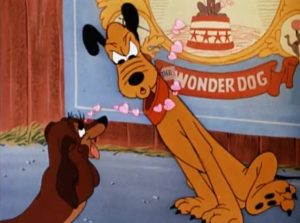 Pluto enters the spotlight, with two small French poodles holding up the corners of his flowing cape. The cape is removed, and Pluto marches into the ring, waving from his tail a small flag bearing the prominent letter “P”. With a bit of unexpected awkwardness, Pluto climbs onto a small platform, then jumps atop a barrel tipped sideways. He attempts to roll the barrel with his feet, but quickly discovers this is much harder to do than it looks, his feet stumbling and slipping out from under him in all directions. A crash wakes Pluto back to reality, where he discovers he had been rolling atop a real barrel in the junkyard, which is now reduced to a loose pile of staves and hoops. The crash has also aroused from slumber Butch the bulldog, who is the resident “Junkyard dog” guard, stationed behind a wire fence. Butch can hardly restrain his giggles and guffaws as he watches Pluto attempt a new string of acts. Pluto tries to jump through an old tire as a hoop, but gets caught in the middle, straddling the tire with his midriff. He mounts a ladder to a wire extended between two poles, but is only able to maintain balance for a few seconds, landing in his belly atop an old car seat cushion below. Pluto tries the ball-balancing act, using a pumpkin for his ball. A mistimed bounce shatters the pumpkin upon his face, covering him with the internal meat and seeds. Butch is now belly-laughing to Pluto’s chagrin. However, Pluto notes that Butch is safely on the other side of the wire fence, with a padlocked gate, so knows the bulldog can’t get at him. Pluto thus attempts to have the last laugh, performing a series of unflattering impersonations of Butch’s walk, jowly face, stomping, and bent tail, that Butch can plainly see is intended to be insulting. Butch growls fiercely, and suddenly, a loud impact and a cloud of dust are raised at the fence line. In one instant, Butch has broken clear through the fence and shattered the gate, free to do what he pleases with Pluto.
Pluto enters the spotlight, with two small French poodles holding up the corners of his flowing cape. The cape is removed, and Pluto marches into the ring, waving from his tail a small flag bearing the prominent letter “P”. With a bit of unexpected awkwardness, Pluto climbs onto a small platform, then jumps atop a barrel tipped sideways. He attempts to roll the barrel with his feet, but quickly discovers this is much harder to do than it looks, his feet stumbling and slipping out from under him in all directions. A crash wakes Pluto back to reality, where he discovers he had been rolling atop a real barrel in the junkyard, which is now reduced to a loose pile of staves and hoops. The crash has also aroused from slumber Butch the bulldog, who is the resident “Junkyard dog” guard, stationed behind a wire fence. Butch can hardly restrain his giggles and guffaws as he watches Pluto attempt a new string of acts. Pluto tries to jump through an old tire as a hoop, but gets caught in the middle, straddling the tire with his midriff. He mounts a ladder to a wire extended between two poles, but is only able to maintain balance for a few seconds, landing in his belly atop an old car seat cushion below. Pluto tries the ball-balancing act, using a pumpkin for his ball. A mistimed bounce shatters the pumpkin upon his face, covering him with the internal meat and seeds. Butch is now belly-laughing to Pluto’s chagrin. However, Pluto notes that Butch is safely on the other side of the wire fence, with a padlocked gate, so knows the bulldog can’t get at him. Pluto thus attempts to have the last laugh, performing a series of unflattering impersonations of Butch’s walk, jowly face, stomping, and bent tail, that Butch can plainly see is intended to be insulting. Butch growls fiercely, and suddenly, a loud impact and a cloud of dust are raised at the fence line. In one instant, Butch has broken clear through the fence and shattered the gate, free to do what he pleases with Pluto.
 The chase is on. Music shifts cleverly to a ringmaster’s whistle, trumpet fanfare, and substantial circus march clips from the score of Dumbo, as Butch’s pursuit of Pluto forces the mutt to encounter the various props in the junkyard, engaging in a full-blown circus performance whether he likes it or not. First, Pluto sails through the tire hoop in a clean jump, Butch smashing into the rubber ring instead since he’s too wide to fit. Pluto scales the ladder again, but is unable to reach the high wire, as Butch tips the base of the ladder away from the pole, then knocks the ladder out from under Pluto entirely. Dinah happens by outside the yard on her return trip home, just in time to see over the top of the fence Pluto falling from the ladder toward the ground. She is unable from her vantage point to see Butch, or just what Pluto is falling toward – but suddenly, Pluto reappears above the fence top, bouncing into view over and over again, as if jumping on a trampoline. In reality, it is the springy car seat cushion that is acting as his trampoline substitute. Inside the yard, Butch attempts to seize Pluto between bounces, but can’t get his timing right to grab him. Butch angrily knocks the cushion away from under Pluto, but by this time, Pluto has caught the high wire above, and is now bouncing up and down atop the wire, again to Dinah’s delight. Butch mounts a tall stack of barrels near one of the poles supporting the wire, and clamps down upon the wire end with his teeth. He cannot sever the wire, but instead tanks it back and forth, causing it to sway violently from side to side. Pluto rides the wire dimensionally, in a camera angle that shifts him intermittently in profile from a considerable distance from the lens to an extreme close-up, nearly flying out of frame into the audience. Butch begins yanking the wire in a circular pattern, causing Pluto to spin round and round the wire, suspended only by his hind paws. Dinah continues to jump for joy. The barrels topple out from under Butch, leaving the bulldog on his back, with a barrel clenched between his hind feet. With a mighty thrust by his hind paws, Butch tosses the barrel up upon the wire, landing it to intercept Pluto’s feet, forcing Pluto to mount the barrel in precarious balance. One by one, Butch hurls more barrels at Pluto. Soon, Pluto is high atop eight rolling barrels perched on the wire. A ninth barrel topples the pile, but sends them into a rotating loop on the wire, with Pluto hopping from barrel to barrel inside the loop. Finally, Pluto begins to force barrels off the wire with his feet, crashing one after another atop Butch’s body, tangling him up in staves and hoops. Pluto himself falls from the wire, bouncing off Butch’s head, and into one end of a large section of pipe. Across the other end of the pipe is stretched a large inner tube, which acts like a slingshot to propel Pluto backwards out the mouth of the pipe, as if shot from a cannon. Pluto sails across the junkyard, his head smashing right through the fence, where it protrudes from the circus poster, in the very place where the face of Prince the Wonder Dog had once been, Dinah is there, to smother Pluto in those little hearts from her fondest gazes, as Pluto strikes a majestic pose in the poster hole, to the sound of a Ringmaster’s whistle, and the close of the cartoon. Another Disney masterpiece.
The chase is on. Music shifts cleverly to a ringmaster’s whistle, trumpet fanfare, and substantial circus march clips from the score of Dumbo, as Butch’s pursuit of Pluto forces the mutt to encounter the various props in the junkyard, engaging in a full-blown circus performance whether he likes it or not. First, Pluto sails through the tire hoop in a clean jump, Butch smashing into the rubber ring instead since he’s too wide to fit. Pluto scales the ladder again, but is unable to reach the high wire, as Butch tips the base of the ladder away from the pole, then knocks the ladder out from under Pluto entirely. Dinah happens by outside the yard on her return trip home, just in time to see over the top of the fence Pluto falling from the ladder toward the ground. She is unable from her vantage point to see Butch, or just what Pluto is falling toward – but suddenly, Pluto reappears above the fence top, bouncing into view over and over again, as if jumping on a trampoline. In reality, it is the springy car seat cushion that is acting as his trampoline substitute. Inside the yard, Butch attempts to seize Pluto between bounces, but can’t get his timing right to grab him. Butch angrily knocks the cushion away from under Pluto, but by this time, Pluto has caught the high wire above, and is now bouncing up and down atop the wire, again to Dinah’s delight. Butch mounts a tall stack of barrels near one of the poles supporting the wire, and clamps down upon the wire end with his teeth. He cannot sever the wire, but instead tanks it back and forth, causing it to sway violently from side to side. Pluto rides the wire dimensionally, in a camera angle that shifts him intermittently in profile from a considerable distance from the lens to an extreme close-up, nearly flying out of frame into the audience. Butch begins yanking the wire in a circular pattern, causing Pluto to spin round and round the wire, suspended only by his hind paws. Dinah continues to jump for joy. The barrels topple out from under Butch, leaving the bulldog on his back, with a barrel clenched between his hind feet. With a mighty thrust by his hind paws, Butch tosses the barrel up upon the wire, landing it to intercept Pluto’s feet, forcing Pluto to mount the barrel in precarious balance. One by one, Butch hurls more barrels at Pluto. Soon, Pluto is high atop eight rolling barrels perched on the wire. A ninth barrel topples the pile, but sends them into a rotating loop on the wire, with Pluto hopping from barrel to barrel inside the loop. Finally, Pluto begins to force barrels off the wire with his feet, crashing one after another atop Butch’s body, tangling him up in staves and hoops. Pluto himself falls from the wire, bouncing off Butch’s head, and into one end of a large section of pipe. Across the other end of the pipe is stretched a large inner tube, which acts like a slingshot to propel Pluto backwards out the mouth of the pipe, as if shot from a cannon. Pluto sails across the junkyard, his head smashing right through the fence, where it protrudes from the circus poster, in the very place where the face of Prince the Wonder Dog had once been, Dinah is there, to smother Pluto in those little hearts from her fondest gazes, as Pluto strikes a majestic pose in the poster hole, to the sound of a Ringmaster’s whistle, and the close of the cartoon. Another Disney masterpiece.
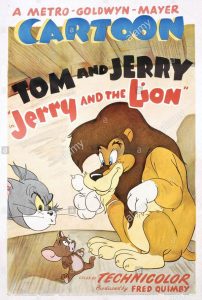 Jerry and the Lion (MGM, Tom and Jerry, 4/8/50 – William Hanna/Joseph Barbera, dir.) – Had alternate titles for this episode been coined, they could have included, “Jerry Meets Leo”, or “All the Fun of Big Game Hunting – In Your Own Living Room”. A typical day finds Jerry rigging up a delivery chute to transport groceries direct from refrigerator to mousehole, using a series of planks, ironing board, etc. Jerry escapes through a private mousehole carved in the cellar door, while carrying a tomato. When Tom peers in through the small door, all he gets is a squirt of tomato juice in his eye. Suddenly, a news bulletin announces the escape of a ferocious lion from the circus, advising immediate locking of all doors and windows. Tom is spurred into panicked action, zooming around the house, and into the cellar past Jerry, to follow such instructions, then takes up a position of barricade in the living room behind a coffee table turned sideways, nervously levels a rifle barrel over the table’s edge, and dons a pith helmet like a real jungle hunter. Jerry creeps out of hiding in the cellar, but has gone no more than a few steps when a shocking sight sends him into a frozen stiffness. Two huge blue eyes are staring at hum from the shadows in a corner. Jerry turns to run, but is quickly nabbed up in the paw of none other than the lion, who was already in the cellar before the windows were closed. Rather than murder or consume Jerry, the lion merely utters a “Shhhh”, then explains. “Don’t give me away, Pal. If they take me back to that circus, I’ll go crazy. I can’t stand that corny music! Or that crackle crackle crackle of them popcorn bags! Say you’ll help me get back to the jungle – puh-leeeze?” The lion smiles his most sympathetic, yet sharply-toothed smile. What can Jerry do but to agree? Plus, there is one other immediate problem – the lion is hungry.
Jerry and the Lion (MGM, Tom and Jerry, 4/8/50 – William Hanna/Joseph Barbera, dir.) – Had alternate titles for this episode been coined, they could have included, “Jerry Meets Leo”, or “All the Fun of Big Game Hunting – In Your Own Living Room”. A typical day finds Jerry rigging up a delivery chute to transport groceries direct from refrigerator to mousehole, using a series of planks, ironing board, etc. Jerry escapes through a private mousehole carved in the cellar door, while carrying a tomato. When Tom peers in through the small door, all he gets is a squirt of tomato juice in his eye. Suddenly, a news bulletin announces the escape of a ferocious lion from the circus, advising immediate locking of all doors and windows. Tom is spurred into panicked action, zooming around the house, and into the cellar past Jerry, to follow such instructions, then takes up a position of barricade in the living room behind a coffee table turned sideways, nervously levels a rifle barrel over the table’s edge, and dons a pith helmet like a real jungle hunter. Jerry creeps out of hiding in the cellar, but has gone no more than a few steps when a shocking sight sends him into a frozen stiffness. Two huge blue eyes are staring at hum from the shadows in a corner. Jerry turns to run, but is quickly nabbed up in the paw of none other than the lion, who was already in the cellar before the windows were closed. Rather than murder or consume Jerry, the lion merely utters a “Shhhh”, then explains. “Don’t give me away, Pal. If they take me back to that circus, I’ll go crazy. I can’t stand that corny music! Or that crackle crackle crackle of them popcorn bags! Say you’ll help me get back to the jungle – puh-leeeze?” The lion smiles his most sympathetic, yet sharply-toothed smile. What can Jerry do but to agree? Plus, there is one other immediate problem – the lion is hungry.

Reissue title card
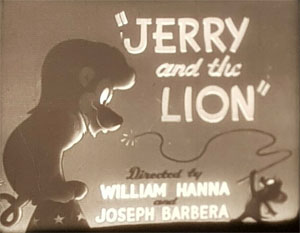
Original title card
 Pop ‘im, Pop (Warner, Sylvester and Hippity Hopper, 10/28/50 – Robert McKimson, dir.) – At the Tingling Brothers Circus, among several posters depicting featured acts (one again harkening back to Dumbo’s “Pyramid of Pachyderms”), is a prominent pose of Gracie, the boxing kangaroo. Gracie herself is inside her dressing tent, practicing her sparring and jabs. She stops momentarily, recalling something she has forgotten, then unzips a zipper in her pouch, releasing Hippity Hopper, who is a little dizzy from all the jostling he has taken inside during his mother’s practice. Someone calls to Gracie from outside that she is due on. Gracie powders her nose and leaves the tent for her performance. Curious Hippity spots a spare pair of boxing gloves, and decides to attempt to follow in mother’s footsteps, placing them on his own wrists. Hippity tries a few left and rights, but overspins ad briefly falls flat. Undaunted, he sets out in the world to look for a sparring partner. On the way, he has a few misadventures, getting tangled up in a woman’s dress from a clothing shop, then snarling traffic as he crosses a street against a light. He also creates a running gag by twice lousing up a cement worker’s pavement job, by splashing large footprint holes on the wet cement.
Pop ‘im, Pop (Warner, Sylvester and Hippity Hopper, 10/28/50 – Robert McKimson, dir.) – At the Tingling Brothers Circus, among several posters depicting featured acts (one again harkening back to Dumbo’s “Pyramid of Pachyderms”), is a prominent pose of Gracie, the boxing kangaroo. Gracie herself is inside her dressing tent, practicing her sparring and jabs. She stops momentarily, recalling something she has forgotten, then unzips a zipper in her pouch, releasing Hippity Hopper, who is a little dizzy from all the jostling he has taken inside during his mother’s practice. Someone calls to Gracie from outside that she is due on. Gracie powders her nose and leaves the tent for her performance. Curious Hippity spots a spare pair of boxing gloves, and decides to attempt to follow in mother’s footsteps, placing them on his own wrists. Hippity tries a few left and rights, but overspins ad briefly falls flat. Undaunted, he sets out in the world to look for a sparring partner. On the way, he has a few misadventures, getting tangled up in a woman’s dress from a clothing shop, then snarling traffic as he crosses a street against a light. He also creates a running gag by twice lousing up a cement worker’s pavement job, by splashing large footprint holes on the wet cement.
 In a nearby yard, Sylvester is attempting to be a big man in front of his son (first appearance of Sylvester Jr.), by telling him whopping tall tales of having battled a giant mouse. At the end of the story, he wonders why his son is looking at him peculiarly. Junior surprises him by announcing that there is a giant mouse right behind him. ‘Oh, come now, kid. I’ll do the fibbin’ around here”, blurts out Sylvester. His paw, however, touches the snout of Hippity, directly behind him. In underplayed reaction, Sylvester calmly pulls from an invisible pocket in his fur a small hand-mirror, blows on it to provide moisture to cleanly polish the glass, then positions it for a view over his shoulder. The bobbing head of Hippity is revealed to view. Watch for a great shock-take by Sylvester, likely animated by Rod Scribner. The film evolves into the usual extended series of fight and clobbering gags as Sylvester finds he is no match for the kangaroo, yet is forced back into the fray by Junior’s encouraging words so as not to appear a coward. (While this setup was used again and again in the course of the series, it feels fresher here, appearing in one of its earlier uses.) Sylvester is finally forced to pursue the kangaroo with an axe, and follows him all the way back to the circus grounds. On route, they pass the same sidewalk of the frustrated cement worker. Hearing their approach, the worker stomps his own footprints into the cement to steal the approacher’s thunder. Instead, Hippity and Sylvester pass without leaving a mark. Giving up on a lost cause, the cement worker stands in the middle of one of the footprint craters, pulls out a small bugle to blow Taps for himself, and sinks into the cement like quicksand. At the circus, Hippity disappears inside Gracie’s tent, and all Sylvester gets for peering in is a pop in the nose from a boxing glove. Junior appears, bringing up the rear, having just missed the botched confrontation. So Sylvester fakes a different result, hurling verbal threats at the empty tent entrance, that if the mouse ever shows himself again, Sylvester will give him more of the same – except next time, he’ll break both the mouse’s legs. Junior is amply impressed at his father’s bravery, and Sylvester continues to build on his bluff, stating he wishes there had been a mouse twice that size, with two heads and four arms. While saying this line, the cats fail to notice Gracie emerging from the tent, carrying Hippity half-hidden inside her pouch, matching Sylvester’s wish description. Sylvester concludes by informing Junior that if there was such a mouse, he’d tell him that this town wasn’t big enough for the two of them, and one of them had to go. Turning to spot the kangaroos, all that Sylvester can do is grin sheepishly, wave his hand, and add, “G’bye, now.” Sylvester darts out of scene, and wisely, so does Junior, for the iris out.
In a nearby yard, Sylvester is attempting to be a big man in front of his son (first appearance of Sylvester Jr.), by telling him whopping tall tales of having battled a giant mouse. At the end of the story, he wonders why his son is looking at him peculiarly. Junior surprises him by announcing that there is a giant mouse right behind him. ‘Oh, come now, kid. I’ll do the fibbin’ around here”, blurts out Sylvester. His paw, however, touches the snout of Hippity, directly behind him. In underplayed reaction, Sylvester calmly pulls from an invisible pocket in his fur a small hand-mirror, blows on it to provide moisture to cleanly polish the glass, then positions it for a view over his shoulder. The bobbing head of Hippity is revealed to view. Watch for a great shock-take by Sylvester, likely animated by Rod Scribner. The film evolves into the usual extended series of fight and clobbering gags as Sylvester finds he is no match for the kangaroo, yet is forced back into the fray by Junior’s encouraging words so as not to appear a coward. (While this setup was used again and again in the course of the series, it feels fresher here, appearing in one of its earlier uses.) Sylvester is finally forced to pursue the kangaroo with an axe, and follows him all the way back to the circus grounds. On route, they pass the same sidewalk of the frustrated cement worker. Hearing their approach, the worker stomps his own footprints into the cement to steal the approacher’s thunder. Instead, Hippity and Sylvester pass without leaving a mark. Giving up on a lost cause, the cement worker stands in the middle of one of the footprint craters, pulls out a small bugle to blow Taps for himself, and sinks into the cement like quicksand. At the circus, Hippity disappears inside Gracie’s tent, and all Sylvester gets for peering in is a pop in the nose from a boxing glove. Junior appears, bringing up the rear, having just missed the botched confrontation. So Sylvester fakes a different result, hurling verbal threats at the empty tent entrance, that if the mouse ever shows himself again, Sylvester will give him more of the same – except next time, he’ll break both the mouse’s legs. Junior is amply impressed at his father’s bravery, and Sylvester continues to build on his bluff, stating he wishes there had been a mouse twice that size, with two heads and four arms. While saying this line, the cats fail to notice Gracie emerging from the tent, carrying Hippity half-hidden inside her pouch, matching Sylvester’s wish description. Sylvester concludes by informing Junior that if there was such a mouse, he’d tell him that this town wasn’t big enough for the two of them, and one of them had to go. Turning to spot the kangaroos, all that Sylvester can do is grin sheepishly, wave his hand, and add, “G’bye, now.” Sylvester darts out of scene, and wisely, so does Junior, for the iris out.
Here are several minutes from the cartoon – for your amusement:
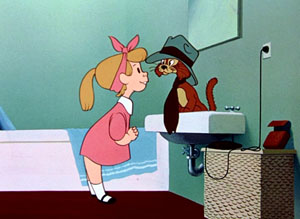 Family Circus (UPA/Columbia, Jolly Frolics, 1/25/51 – Art Babbitt, dir.) – Not to be confused with the popular comic strip of the same name, which was not created until nearly a decade later. While most of this film is presented in surprisingly full animation for a UPA film, there is a certain strangeness about the production that is signature to many of the studio’s experimental one-shots. John Hubley receives screen credit as “Supervising Director”, and it may be that this film hints at things to come in John’s later offbeat juvenile studies such as “Moonbird” and “Windy Day”. A young girl of about five or six years, Patsy, has a habit of chronically misbehaving. She seems to mean well, and to herself sings a little song about “Daddy, Daddy, Patsy loves you” – but there is a fly in her ointment, in the form of a toddler baby son, who is the current apple of Daddy’s eye – so much so, that Dad seems to lavish all his attention upon the new boy, virtually forgetting the needs of his older girl. We in the audience can see the root of the problem right from the start – but Daddy takes a full seven minutes of misadventures before getting the message. There is something about the semi-realistic presentation of both the father and daughter characters and the storyline in general that seems to undermine even the best visual gags conceived by the writers, making us feel more like we are watching an educational film in a psychology class rather than an entertainment. (This was a problem that Pixar’s later “Inside Out” largely managed to avoid with skillful writing and innovative ideas, while tackling even more complex psychological dilemmas. Let’s pray that they are up to the task again in the forthcoming sequel.) It also compares in a negative way against “Lady and the Tramp”’s later “What is a Baby?” sequence, in close parallel to the notion that “A human heart has only so much room for love and affection. When a baby moves in, a dog moves out.” The Disney version is again more subtle, less jarring, and with a more rewarding payoff.
Family Circus (UPA/Columbia, Jolly Frolics, 1/25/51 – Art Babbitt, dir.) – Not to be confused with the popular comic strip of the same name, which was not created until nearly a decade later. While most of this film is presented in surprisingly full animation for a UPA film, there is a certain strangeness about the production that is signature to many of the studio’s experimental one-shots. John Hubley receives screen credit as “Supervising Director”, and it may be that this film hints at things to come in John’s later offbeat juvenile studies such as “Moonbird” and “Windy Day”. A young girl of about five or six years, Patsy, has a habit of chronically misbehaving. She seems to mean well, and to herself sings a little song about “Daddy, Daddy, Patsy loves you” – but there is a fly in her ointment, in the form of a toddler baby son, who is the current apple of Daddy’s eye – so much so, that Dad seems to lavish all his attention upon the new boy, virtually forgetting the needs of his older girl. We in the audience can see the root of the problem right from the start – but Daddy takes a full seven minutes of misadventures before getting the message. There is something about the semi-realistic presentation of both the father and daughter characters and the storyline in general that seems to undermine even the best visual gags conceived by the writers, making us feel more like we are watching an educational film in a psychology class rather than an entertainment. (This was a problem that Pixar’s later “Inside Out” largely managed to avoid with skillful writing and innovative ideas, while tackling even more complex psychological dilemmas. Let’s pray that they are up to the task again in the forthcoming sequel.) It also compares in a negative way against “Lady and the Tramp”’s later “What is a Baby?” sequence, in close parallel to the notion that “A human heart has only so much room for love and affection. When a baby moves in, a dog moves out.” The Disney version is again more subtle, less jarring, and with a more rewarding payoff.
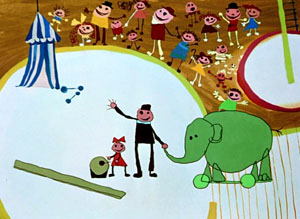 Patsy begins the film coveting the new baby’s toys, which nearly fill the playpen. She “borrows” several items from his stockpile, sing-songing about loving them, and when she reaches a part of her song that should logically end with “Patsy loves baby”, she substitutes a loud “Boo” in the baby’s face, causing him to cry. Daddy arrives home, carrying a pull toy in the form of a green circus elephant. Patsy tries to fondly greet Daddy, but Dad only asks where that big boy of his is. Patsy asks if the toy is for her, but Daddy quickly explains that it is for the baby, and suggests she bring it upstairs to give to him. Patsy instead sets the elephant on an upstairs staircase railing, and sets off a chain reaction between a toy canon, jack-in-the-box, and ball taken from the baby’s room to knock the elephant off the railing, making it fall and hit Daddy on the head coming upstairs. Daddy barks some angry words, but at least delivers no Little Lulu spankings. Daddy spends some “quality time” with Junior, imagining with the aid of a stray soap bubble how Junior will excel as a college football star in receiving long passes. As he fades back to receive the bubble, his catch is intercepted by a stream of bubbles filling the air, created by Patsy blowing into six of Daddy’s favorite pipes filled with soapy water all at once (another stunt referred to in Little Lulu’s theme song). Patsy engages in many other acts of random mischief, some possibly intended to get attention, others seeming to be committed only to fill time in the absence of Daddy’s supervision. She practices putting with Daddy’s clubs and golf balls on the kitchen counter, the balls scoring holes in one down the sink garbage disposal. She hides the club behind her back when Daddy enters the room. Daddy says “Drop it”, and the club handle is quickly chomped up inside the hole of the disposal. Patsy dresses her cat to look like Daddy in the bathroom, and administers a facial shave to the feline with Daddy’s new electric shaver.
Patsy begins the film coveting the new baby’s toys, which nearly fill the playpen. She “borrows” several items from his stockpile, sing-songing about loving them, and when she reaches a part of her song that should logically end with “Patsy loves baby”, she substitutes a loud “Boo” in the baby’s face, causing him to cry. Daddy arrives home, carrying a pull toy in the form of a green circus elephant. Patsy tries to fondly greet Daddy, but Dad only asks where that big boy of his is. Patsy asks if the toy is for her, but Daddy quickly explains that it is for the baby, and suggests she bring it upstairs to give to him. Patsy instead sets the elephant on an upstairs staircase railing, and sets off a chain reaction between a toy canon, jack-in-the-box, and ball taken from the baby’s room to knock the elephant off the railing, making it fall and hit Daddy on the head coming upstairs. Daddy barks some angry words, but at least delivers no Little Lulu spankings. Daddy spends some “quality time” with Junior, imagining with the aid of a stray soap bubble how Junior will excel as a college football star in receiving long passes. As he fades back to receive the bubble, his catch is intercepted by a stream of bubbles filling the air, created by Patsy blowing into six of Daddy’s favorite pipes filled with soapy water all at once (another stunt referred to in Little Lulu’s theme song). Patsy engages in many other acts of random mischief, some possibly intended to get attention, others seeming to be committed only to fill time in the absence of Daddy’s supervision. She practices putting with Daddy’s clubs and golf balls on the kitchen counter, the balls scoring holes in one down the sink garbage disposal. She hides the club behind her back when Daddy enters the room. Daddy says “Drop it”, and the club handle is quickly chomped up inside the hole of the disposal. Patsy dresses her cat to look like Daddy in the bathroom, and administers a facial shave to the feline with Daddy’s new electric shaver.
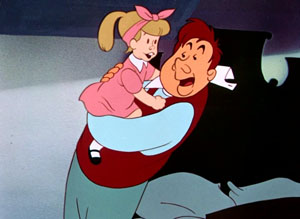 Daddy pulls it away, and tells her to clean up the mess – so Patsy tosses the cat into the washing machine. (Funny when it happens to Sylvester or Humphrey Bear, but nowhere near drawing such laughs here.) Daddy tucks Junior in for the night, and shuts out the nursery light – just as Patsy parades past the room playing a miniature bass drum. Daddy chases Patsy into her own room, while the girl hides under the bed. Daddy stands in the doorway, aghast at a view of the opposite wall, with wallpaper scrawled upon in crayon with child-styled circus drawings featuring Patsy and Daddy. Daddy charges into the room, but Patsy tosses into his path the green elephant push toy. Daddy stumbles, whacking his head into the crayon-covered wall. For a full minute, the animation style changes completely, as we are thrust into Patsy’s drawings, where Patsy happily performs with Daddy before an audience of stick-figure patrons, upon the high wire and trapeze. (This sequence may be one of the first in theatrical animation mimicking children’s drawings, which may count as the film’s only true innovation – to be copycatted years later in such Paramount shorts as “The Story of George Washington” and “My Daddy, the Astronaut”, and even by Disney in the “inspiration” segment of “Adventures In Music – Melody”.) The act progresses fine until the baby appears in drawing form to join in the performance. Daddy catches the baby, leaving Patsy to fall to the ground on her head (depicted in a non-painful looking bounce so as not to be fatal). Drawn Patsy picks up from the arena floor the green elephant, and tosses it into the air at Daddy, conking him where he sits on the trapeze with the baby. Then Daddy awakens back to reality. Getting the true message behind his daughter’s behavior all of a sudden, he playfully pretends to be looking for Patsy in all the wrong places upon her bed, making it into a game instead of a disciplinary pursuit, and gets her giggling. She finally reveals herself, with Daddy fondly referring to her as his “big girl” and holding her in an embrace. Breaking the fourth wall for the first time in the film, Daddy addresses the audience: “Everything is going to be all right.” There is a small surprise twist, approaching the film’s only laugh, as Daddy is again conked by a throw of the green elephant. The pitcher of same is – Junior, who is now jealous of Patsy finally getting attention. Daddy shrugs to the audience, as if to acknowledge that balancing the needs of these two will ever be a constant problem.
Daddy pulls it away, and tells her to clean up the mess – so Patsy tosses the cat into the washing machine. (Funny when it happens to Sylvester or Humphrey Bear, but nowhere near drawing such laughs here.) Daddy tucks Junior in for the night, and shuts out the nursery light – just as Patsy parades past the room playing a miniature bass drum. Daddy chases Patsy into her own room, while the girl hides under the bed. Daddy stands in the doorway, aghast at a view of the opposite wall, with wallpaper scrawled upon in crayon with child-styled circus drawings featuring Patsy and Daddy. Daddy charges into the room, but Patsy tosses into his path the green elephant push toy. Daddy stumbles, whacking his head into the crayon-covered wall. For a full minute, the animation style changes completely, as we are thrust into Patsy’s drawings, where Patsy happily performs with Daddy before an audience of stick-figure patrons, upon the high wire and trapeze. (This sequence may be one of the first in theatrical animation mimicking children’s drawings, which may count as the film’s only true innovation – to be copycatted years later in such Paramount shorts as “The Story of George Washington” and “My Daddy, the Astronaut”, and even by Disney in the “inspiration” segment of “Adventures In Music – Melody”.) The act progresses fine until the baby appears in drawing form to join in the performance. Daddy catches the baby, leaving Patsy to fall to the ground on her head (depicted in a non-painful looking bounce so as not to be fatal). Drawn Patsy picks up from the arena floor the green elephant, and tosses it into the air at Daddy, conking him where he sits on the trapeze with the baby. Then Daddy awakens back to reality. Getting the true message behind his daughter’s behavior all of a sudden, he playfully pretends to be looking for Patsy in all the wrong places upon her bed, making it into a game instead of a disciplinary pursuit, and gets her giggling. She finally reveals herself, with Daddy fondly referring to her as his “big girl” and holding her in an embrace. Breaking the fourth wall for the first time in the film, Daddy addresses the audience: “Everything is going to be all right.” There is a small surprise twist, approaching the film’s only laugh, as Daddy is again conked by a throw of the green elephant. The pitcher of same is – Junior, who is now jealous of Patsy finally getting attention. Daddy shrugs to the audience, as if to acknowledge that balancing the needs of these two will ever be a constant problem.
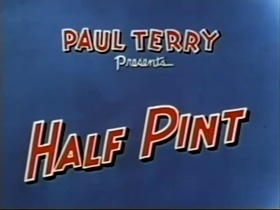 Stage Struck (Terrytoons/Fox, Half Pint, 2/51 – Mannie Davis, dir.) – Some characters whom the Terry studio would attempt to introduce from time to time would first appear anonymously in some miscellaneous one-shot before receiving a series banner of their own (including Heckle and Jeckle, Dingbat, and Dimwit as examples). Others would receive name billing right from the start, with apparent high hopes of instantly launching a new series. Half Pint, a white baby elephant, bearing no accidental resemblance to Dumbo, except with smaller ears, was one of these latter would-be “stars”, but only outlasted other forgotten character launches such as Victor the Volunteer and Clancy the Bull by a single solitary follow-up episode after his inaugural cartoon (discussed further below). It appeared the writers had no idea what to do with the character after his initial circus story, and either gave up from lack of inspiration or lack of positive audience reaction.
Stage Struck (Terrytoons/Fox, Half Pint, 2/51 – Mannie Davis, dir.) – Some characters whom the Terry studio would attempt to introduce from time to time would first appear anonymously in some miscellaneous one-shot before receiving a series banner of their own (including Heckle and Jeckle, Dingbat, and Dimwit as examples). Others would receive name billing right from the start, with apparent high hopes of instantly launching a new series. Half Pint, a white baby elephant, bearing no accidental resemblance to Dumbo, except with smaller ears, was one of these latter would-be “stars”, but only outlasted other forgotten character launches such as Victor the Volunteer and Clancy the Bull by a single solitary follow-up episode after his inaugural cartoon (discussed further below). It appeared the writers had no idea what to do with the character after his initial circus story, and either gave up from lack of inspiration or lack of positive audience reaction.
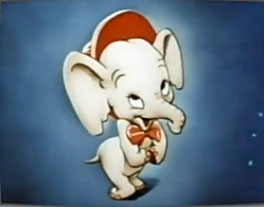 A circus parade opens the show, with old animation reappearing again from practically every Terry circus cartoon we’ve previously reviewed. (I leave you to play detective and recall from which you’ve previously seen each shot). Further animation is reused in a long shot depicting numerous trapeze artists in simultaneous performance, and in a repeated gag of a tattooed strong man whose illustrated battleship sinks beneath the waves upon receiving a blow to the chest. Amid all this hullabaloo is a baby white elephant, being pushed along in a baby carriage by a larger elephant. Half Pint is the baby’s name, and this is his first parade. In accordance with his similarity to Dumbo, Half Pint does not speak, but only trumpets and reacts in pantomime. The elephants parade into the big top in usual trunk-holding-rail fashion. Half Pint tries to join the parade, by taking hold of the last adult elephant’s tail, but suspending himself aloft at its level by means of a balloon tied to his own tail. The Ringmaster wants no such nonsense, and carries Half Pint back to his stroller, slapping a bottle of milk into his trunk, and reminding him that he still has to grow some before he can be part of the show. Half Pint doesn’t like no for an answer, and, when the Ringmaster’s back is turned, gives him a quick kick in the pants, then darts back to feign sleep in his baby carriage, the image of an angel’s halo appearing over his seemingly-sleeping head. When the Ringmaster leaves him again, Half Pint cautiously creeps back to the tent entrance, hiding behind grandstand posts, his trunk first creeping forward as if walking on tiptoe, followed by the rest of him. The elephants are engaged in a spirited fox-trot dance in the center ring, so Half Pint decides to provide them musical accompaniment. Sour notes are soon heard among the circus band, as Half Pint appears among them, trying to toot notes by blowing through his trunk like a trumpet. The Ringmaster turns to eject the little intruder again, and finds him morphed in shape to masquerade behind a small staircase to the grandstand (borrowing a gag from “The Big Wash”). The Ringmaster administers a spanking, which turns Half-Pint’s rump red. Half Pint runs to a watering pail, sucking up water, then spraying it on his posterior to cool off the swelling.
A circus parade opens the show, with old animation reappearing again from practically every Terry circus cartoon we’ve previously reviewed. (I leave you to play detective and recall from which you’ve previously seen each shot). Further animation is reused in a long shot depicting numerous trapeze artists in simultaneous performance, and in a repeated gag of a tattooed strong man whose illustrated battleship sinks beneath the waves upon receiving a blow to the chest. Amid all this hullabaloo is a baby white elephant, being pushed along in a baby carriage by a larger elephant. Half Pint is the baby’s name, and this is his first parade. In accordance with his similarity to Dumbo, Half Pint does not speak, but only trumpets and reacts in pantomime. The elephants parade into the big top in usual trunk-holding-rail fashion. Half Pint tries to join the parade, by taking hold of the last adult elephant’s tail, but suspending himself aloft at its level by means of a balloon tied to his own tail. The Ringmaster wants no such nonsense, and carries Half Pint back to his stroller, slapping a bottle of milk into his trunk, and reminding him that he still has to grow some before he can be part of the show. Half Pint doesn’t like no for an answer, and, when the Ringmaster’s back is turned, gives him a quick kick in the pants, then darts back to feign sleep in his baby carriage, the image of an angel’s halo appearing over his seemingly-sleeping head. When the Ringmaster leaves him again, Half Pint cautiously creeps back to the tent entrance, hiding behind grandstand posts, his trunk first creeping forward as if walking on tiptoe, followed by the rest of him. The elephants are engaged in a spirited fox-trot dance in the center ring, so Half Pint decides to provide them musical accompaniment. Sour notes are soon heard among the circus band, as Half Pint appears among them, trying to toot notes by blowing through his trunk like a trumpet. The Ringmaster turns to eject the little intruder again, and finds him morphed in shape to masquerade behind a small staircase to the grandstand (borrowing a gag from “The Big Wash”). The Ringmaster administers a spanking, which turns Half-Pint’s rump red. Half Pint runs to a watering pail, sucking up water, then spraying it on his posterior to cool off the swelling.
 Half Pint next sneaks in amidst a troupe of performing seals (some of the seal shots are more recycled animation), balancing a ball on his trunk. The Ringmaster again ejects him, warning him not to show his face inside the tent again. “You’re no performer”, he shouts, as he snaps a collar around Half Pint, chained to a wagon wheel. Half Pint aims another kick at the exiting Ringmaster, but misses, instead yanking off the wagon wheel and somehow snapping off his chain and collar. The wheel gives him an idea, and he intrudes upon the Ringmaster’s announcement of the grand finale, by riding into the arena, using the wheel as a unicycle. He has little control of the wheel once started. He collides with the lion tamer, knocking him through the lion’s stomach and inside the lion’s tail. He then rolls over one of the seals, colliding with the seal’s ball and rising into the air with it. Half Pint takes a bounce off a safety net, then lands with the ball upon an acrobatic team’s teeter-totter, catapulting them through the tent roof. The human cannonball ducks inside his cannon, and another bounce of Half Pint and the ball trigger off the cannon’s firing mechanism. The cannon man is launched into the chest of the strong man, sinking his battleship tattoo as previously mentioned. Half Pint keeps bouncing, until the Ringmaster draws out a pistol and fires a shot through the ball. The ball becomes a jet-propelled deflating balloon, and pursues the Ringmaster. He dives into the center of a circle of elephants, as the ball plunges like a comet from the heavens. It collides with the circle of elephants in an explosion. In a final homage to Dumbo, a pyramid of pachyderms is created, with the Ringmaster nose-first in the sawdust at the bottom of it, and Half Pint in glory at the top of it, the new star of the circus.
Half Pint next sneaks in amidst a troupe of performing seals (some of the seal shots are more recycled animation), balancing a ball on his trunk. The Ringmaster again ejects him, warning him not to show his face inside the tent again. “You’re no performer”, he shouts, as he snaps a collar around Half Pint, chained to a wagon wheel. Half Pint aims another kick at the exiting Ringmaster, but misses, instead yanking off the wagon wheel and somehow snapping off his chain and collar. The wheel gives him an idea, and he intrudes upon the Ringmaster’s announcement of the grand finale, by riding into the arena, using the wheel as a unicycle. He has little control of the wheel once started. He collides with the lion tamer, knocking him through the lion’s stomach and inside the lion’s tail. He then rolls over one of the seals, colliding with the seal’s ball and rising into the air with it. Half Pint takes a bounce off a safety net, then lands with the ball upon an acrobatic team’s teeter-totter, catapulting them through the tent roof. The human cannonball ducks inside his cannon, and another bounce of Half Pint and the ball trigger off the cannon’s firing mechanism. The cannon man is launched into the chest of the strong man, sinking his battleship tattoo as previously mentioned. Half Pint keeps bouncing, until the Ringmaster draws out a pistol and fires a shot through the ball. The ball becomes a jet-propelled deflating balloon, and pursues the Ringmaster. He dives into the center of a circle of elephants, as the ball plunges like a comet from the heavens. It collides with the circle of elephants in an explosion. In a final homage to Dumbo, a pyramid of pachyderms is created, with the Ringmaster nose-first in the sawdust at the bottom of it, and Half Pint in glory at the top of it, the new star of the circus.
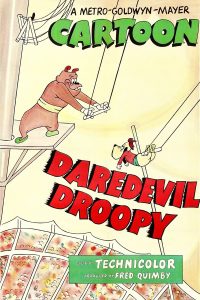 Daredevil Droopy (MGM, Droopy, 3/31/51 – Tex Avery, dir.) – A circus daredevil is wanted, and Droopy and bulldog Butch are the two applicants. As there is only one job to offer, the Ringmaster puts things on a competitive basis – the one who excels in his performance gets the job. The usual battle of half-wits and double-crosses ensues. A weight lifting exhibition has Butch paste over the zeroes of the “1,000 pounds” numbering on a set of barbells to make Droopy look like he’s accomplishing nothing. Butch is surprised, however, when Droopy lifts the barbells with ease. Butch mounts the stage to show he can do the same, just as the pasted labels fall off to reveal the full “1,000 pounds”. Instantly, Butch and the barbells fall through the floor from the added numeric weight. Strength is further exhibited on the circus high-striker. Butch rings the bell instantly, then hands the mallet to Droopy. As Droopy swings, Butch leaps upon the other end of the launching board to hold the weight down to the ground. Instead, Butch’s head is launched off his neck to strike the bell. Target practice is next at the circus shooting gallery. Butch pops five ballons with pinpoint accuracy – but before handing the rifle to Droopy, bends its barrel into a U. Droopy fires, and the bullet takes a U-turn behind him, curving around Butch’s back, and pops Butch’s rump as if it were just another deflating balloon.
Daredevil Droopy (MGM, Droopy, 3/31/51 – Tex Avery, dir.) – A circus daredevil is wanted, and Droopy and bulldog Butch are the two applicants. As there is only one job to offer, the Ringmaster puts things on a competitive basis – the one who excels in his performance gets the job. The usual battle of half-wits and double-crosses ensues. A weight lifting exhibition has Butch paste over the zeroes of the “1,000 pounds” numbering on a set of barbells to make Droopy look like he’s accomplishing nothing. Butch is surprised, however, when Droopy lifts the barbells with ease. Butch mounts the stage to show he can do the same, just as the pasted labels fall off to reveal the full “1,000 pounds”. Instantly, Butch and the barbells fall through the floor from the added numeric weight. Strength is further exhibited on the circus high-striker. Butch rings the bell instantly, then hands the mallet to Droopy. As Droopy swings, Butch leaps upon the other end of the launching board to hold the weight down to the ground. Instead, Butch’s head is launched off his neck to strike the bell. Target practice is next at the circus shooting gallery. Butch pops five ballons with pinpoint accuracy – but before handing the rifle to Droopy, bends its barrel into a U. Droopy fires, and the bullet takes a U-turn behind him, curving around Butch’s back, and pops Butch’s rump as if it were just another deflating balloon.
 “The Flying Human” has Butch and Droopy in aerial outfits, with motors and propellers strapped atop their heads. Droopy spins his prop and soars straight up. Butch spins his, but has his motor somehow in reverse, and submerges into the earth, as his prop bores a deep crater. Jumping into racing cars, Droopy is first to achieve speed to burst his car through a hole made by his vehicle through a solid brick wall. Butch tries the same stunt with a black race car twice the size of Droopy’s – bit all that results from the crash is the conversion of the car into an old Model T. The two dogs “cooperate” in a sharp-shooting act, though Butch, acting as target, places only blank cartridges in a pistol he hands to Droopy. Butch takes his place in the target area, holding a cigarette of the tip of his tongue clenched between his teeth. Droopy, however, substitutes his own weapon of choice, and fires a live round, missing the cigarette, but leaving a gaping bullet hole in Butch’s teeth. Droopy performs a juggling act with about ten balls, while Butch tosses in another two – two black bombs. Droopy tosses all the spheres with precision, then neatly catches all the rubber balls with both hands, takes his bow, and exits. Butch steps into the spot, counting the balls left on the floor, and can’t find a trace of the bombs. He spreads his arms to shrug his shoulders in confusion to the audience – as the two bombs finally descend from the sky, landing in both of his outstretched paws. A double-boom blackens and blasts Butch’s face from both sides.
“The Flying Human” has Butch and Droopy in aerial outfits, with motors and propellers strapped atop their heads. Droopy spins his prop and soars straight up. Butch spins his, but has his motor somehow in reverse, and submerges into the earth, as his prop bores a deep crater. Jumping into racing cars, Droopy is first to achieve speed to burst his car through a hole made by his vehicle through a solid brick wall. Butch tries the same stunt with a black race car twice the size of Droopy’s – bit all that results from the crash is the conversion of the car into an old Model T. The two dogs “cooperate” in a sharp-shooting act, though Butch, acting as target, places only blank cartridges in a pistol he hands to Droopy. Butch takes his place in the target area, holding a cigarette of the tip of his tongue clenched between his teeth. Droopy, however, substitutes his own weapon of choice, and fires a live round, missing the cigarette, but leaving a gaping bullet hole in Butch’s teeth. Droopy performs a juggling act with about ten balls, while Butch tosses in another two – two black bombs. Droopy tosses all the spheres with precision, then neatly catches all the rubber balls with both hands, takes his bow, and exits. Butch steps into the spot, counting the balls left on the floor, and can’t find a trace of the bombs. He spreads his arms to shrug his shoulders in confusion to the audience – as the two bombs finally descend from the sky, landing in both of his outstretched paws. A double-boom blackens and blasts Butch’s face from both sides.
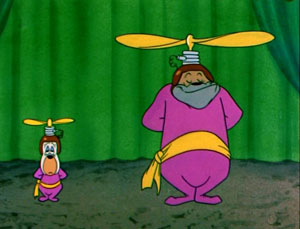 Droopy drives a motorcycle through a flaming hoop. Butch tries the same, but is reduced to a charred outline, while his vehicle is likewise reduced to the outline of a pedaled bicycle. Butch assists Droopy in a trapeze act, holding out trapeze bars for Droopy to catch on each swing. The third bar he attempts to slip to Droopy is a long red stick of lit dynamite. But Droopy never shows up for the return swing, leaving Butch holding the stick. To escape the blast, Butch jumps from the high platform to a net below. However, the net is so springy, it bounces Butch right back up to the platform, just in time for the blast to convert Butch into blackface. Droopy crosses a high wire, using a pair of parasols for balance. Butch cuts the rope at the other end – but his platform falls away instead of the rope. Butch sees a safety net below, and assumes a relaxed position, knowing he will be safe. Instead, the net strings act like razor wire, slicing Butch into a pile of small diced cubes. In an odd inclusion in a circus setting, Butch and Droopy are asked to perform skating moves as if in an ice show. Butch performs a perfect figure 8, but Droopy tops him by skating into the ice “4 + 4″. A human cannonball act is successfully performed by Droopy for a very short flight into a net. Butch tries the same stunt from the same cannon, and ends up blasted clear out of the tent, across a bay, and smack into the side of an ocean liner, which sinks below the waves. For a grand finale, Droopy attempts a dive off a high platform. Butch tries to crab the act, by placing a match in Droopy’s shoe for a hotfoot. Droopy receives the painful shock, but somehow converts it to an advantage, hopping and jumping like mad across the high wire, onto trapeze bars, around loop de loops, and all over the arena like a jumping flea, to the cheers of the crowd. All Droopy can remark is an underplayed “Ouch.” The Ringmaster shakes his hand, awarding the position to Droopy. Jealous Butch makes one last attempt to do Droopy in. In a gag Avery would often repeat (I believe it may have first appeared in “Droopy’s Good Deed”), Butch chops away at the center pole of the tent like a giant tree, steps around behind it as it starts to topple, and begins to yell “TIM…” The pole reverses direction in fall, and comes crashing down on Butch, who remains standing in a hole driven by his body through the wooden pole, to compete his word in abrupt and puzzled tone, “…BER?”
Droopy drives a motorcycle through a flaming hoop. Butch tries the same, but is reduced to a charred outline, while his vehicle is likewise reduced to the outline of a pedaled bicycle. Butch assists Droopy in a trapeze act, holding out trapeze bars for Droopy to catch on each swing. The third bar he attempts to slip to Droopy is a long red stick of lit dynamite. But Droopy never shows up for the return swing, leaving Butch holding the stick. To escape the blast, Butch jumps from the high platform to a net below. However, the net is so springy, it bounces Butch right back up to the platform, just in time for the blast to convert Butch into blackface. Droopy crosses a high wire, using a pair of parasols for balance. Butch cuts the rope at the other end – but his platform falls away instead of the rope. Butch sees a safety net below, and assumes a relaxed position, knowing he will be safe. Instead, the net strings act like razor wire, slicing Butch into a pile of small diced cubes. In an odd inclusion in a circus setting, Butch and Droopy are asked to perform skating moves as if in an ice show. Butch performs a perfect figure 8, but Droopy tops him by skating into the ice “4 + 4″. A human cannonball act is successfully performed by Droopy for a very short flight into a net. Butch tries the same stunt from the same cannon, and ends up blasted clear out of the tent, across a bay, and smack into the side of an ocean liner, which sinks below the waves. For a grand finale, Droopy attempts a dive off a high platform. Butch tries to crab the act, by placing a match in Droopy’s shoe for a hotfoot. Droopy receives the painful shock, but somehow converts it to an advantage, hopping and jumping like mad across the high wire, onto trapeze bars, around loop de loops, and all over the arena like a jumping flea, to the cheers of the crowd. All Droopy can remark is an underplayed “Ouch.” The Ringmaster shakes his hand, awarding the position to Droopy. Jealous Butch makes one last attempt to do Droopy in. In a gag Avery would often repeat (I believe it may have first appeared in “Droopy’s Good Deed”), Butch chops away at the center pole of the tent like a giant tree, steps around behind it as it starts to topple, and begins to yell “TIM…” The pole reverses direction in fall, and comes crashing down on Butch, who remains standing in a hole driven by his body through the wooden pole, to compete his word in abrupt and puzzled tone, “…BER?”
Here is the first three minutes – so you can see the quality of the blu ray version (now on sale)! End of plug.
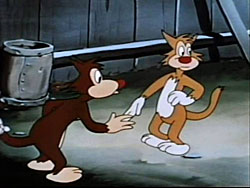 The Elephant Mouse (Terrytoons/Fox, Half Pint, 5/1/51 -Mannie Davis. dir.) – This disappointing follow-up to Half-Pint’s brief screen career is barely a circus story at all, but instead a poor-man’s version of a Sylvester and Hippety Hopper episode, patterned primarily after the initial episode of the Warner series, “Hop, Look, and Listen”. The story begins with a brief shot inside the circus tent, with most of the elephants bedded down for the night. Half Pint’s mother is rocking her baby to sleep by letting him ride atop her trunk as she sways her head back and forth (in exactly the manner performed by Mrs. Jumbo for Dumbo years earlier). As Mom nods off to sleep, Half Pint playfully slips away under the tent, and wanders into town, looking for nothing in particular. He happens upon a house, with a fairly large mousehole visible in one wall. Half Pint investigates it with his trunk, and discovers he is just small enough to forcefully squeeze his way inside. Within the walls, he causes a commotion, as all the mice who live in the house are forcibly driven out through an interior mousehole by the elephant’s bulging girth. As Half Pint enters the interior room, the mice scatter past a cat, sleeping proudly below an array of award medals and commemorative plaques upon the wall, proclaiming his fame as a world’s champion mouser. (One framed award even includes a gloved three-dimensional hand jutting out from the wall, pointing at the cat in his sleeping place, with the caption, “Our Hero”.) The cat is awakened as the mice scamper by, and reaches out to grab one of the rodents. The rodent squeaks out a message in panic, pointing back toward the huge creature that frightened them all. Dropping the mouse, the cat quickly moves to the other side of the room to investigate. He comes face to face with Half Pint, who has somehow gotten his tail caught in a mousetrap. Half Pint blows a trumpet note at the cat through his trunk, frightening the cat backwards and out the front door.
The Elephant Mouse (Terrytoons/Fox, Half Pint, 5/1/51 -Mannie Davis. dir.) – This disappointing follow-up to Half-Pint’s brief screen career is barely a circus story at all, but instead a poor-man’s version of a Sylvester and Hippety Hopper episode, patterned primarily after the initial episode of the Warner series, “Hop, Look, and Listen”. The story begins with a brief shot inside the circus tent, with most of the elephants bedded down for the night. Half Pint’s mother is rocking her baby to sleep by letting him ride atop her trunk as she sways her head back and forth (in exactly the manner performed by Mrs. Jumbo for Dumbo years earlier). As Mom nods off to sleep, Half Pint playfully slips away under the tent, and wanders into town, looking for nothing in particular. He happens upon a house, with a fairly large mousehole visible in one wall. Half Pint investigates it with his trunk, and discovers he is just small enough to forcefully squeeze his way inside. Within the walls, he causes a commotion, as all the mice who live in the house are forcibly driven out through an interior mousehole by the elephant’s bulging girth. As Half Pint enters the interior room, the mice scatter past a cat, sleeping proudly below an array of award medals and commemorative plaques upon the wall, proclaiming his fame as a world’s champion mouser. (One framed award even includes a gloved three-dimensional hand jutting out from the wall, pointing at the cat in his sleeping place, with the caption, “Our Hero”.) The cat is awakened as the mice scamper by, and reaches out to grab one of the rodents. The rodent squeaks out a message in panic, pointing back toward the huge creature that frightened them all. Dropping the mouse, the cat quickly moves to the other side of the room to investigate. He comes face to face with Half Pint, who has somehow gotten his tail caught in a mousetrap. Half Pint blows a trumpet note at the cat through his trunk, frightening the cat backwards and out the front door.
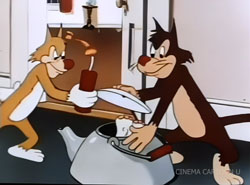 Despite the elephant’s fully-visible trunk and differently-shaped ears, the cat informs two other cats in the alley that he has just encountered a giant mouse. (A poor choice of voices is used for the cat, who talks like Gandy Goose. Wouldn’t a champion mouser be more likely to talk in a gruff voice like Sourpuss, or the Terry bulldog?) The other two cats think he’s crazy, and in disgust for his cowardice toss him back inside through the window (a direct lift of the Warner bulldog’s behavior in “Hop, Look, and Listen”). Routine situations abound as Half Pint raids the refrigerator, squirting the cat with milk through his trunk. Half Pint uses a trunk hold to toss the cat outside again, where the alley cats toss him inside once more. The cat saws a hole large enough to push Half Pint back into the wall, then boards up the hole. But Half Pint merely bursts through another wall, then pursues the cat with his own hammer. Finally, the alley cats get a glimpse of Half Pint pushing the champion cat through one wall after another, and join forces with the champ to gang up on him. At one point, the alley cats clamp down an inverted teapot over Half Pint, flip the pot over to toss in a lighted firecracker, then place the lid on the pot and sit atop it to shut the elephant inside. Reversing a nearly-identical gag from Tom ad Jerry’s “The Yankee Doodle Mouse”, instead of escaping through the teapot spout like Jerry did, Half Pint ejects through the spout the firecracker with his trunk, placing it balanced on one of the cat’s tails. BOOM! The two alley cats are blasted outside, one driven completely inside of, and popping out of, the other’s mouth. The two cats run together, one clinging to the other’s tail, down a railroad track with the sound effect of an express-train, out of sight. The champ meanwhile catches up with Half Pint, and begins to give him a spanking. Half Pint trumpets, and stomping hoofs are heard, as angry Mama elephant crashes inside through the wall. She administers swift justice, in action only seen by the shaking, bulging, and vibrations of the entire house, leaving cat and premises in a shambles. The cat takes out his frustration upon his wall of awards, smashing and tearing down every one, then pulling out a pistol in attempt to blow his brains out. The pistol is only a gag prop with an emerging flag reading “Bang”, bit the cat keels over as if dead anyway, pausing only to briefly arise and address the audience: “That was the biggest mouse I ever saw.”
Despite the elephant’s fully-visible trunk and differently-shaped ears, the cat informs two other cats in the alley that he has just encountered a giant mouse. (A poor choice of voices is used for the cat, who talks like Gandy Goose. Wouldn’t a champion mouser be more likely to talk in a gruff voice like Sourpuss, or the Terry bulldog?) The other two cats think he’s crazy, and in disgust for his cowardice toss him back inside through the window (a direct lift of the Warner bulldog’s behavior in “Hop, Look, and Listen”). Routine situations abound as Half Pint raids the refrigerator, squirting the cat with milk through his trunk. Half Pint uses a trunk hold to toss the cat outside again, where the alley cats toss him inside once more. The cat saws a hole large enough to push Half Pint back into the wall, then boards up the hole. But Half Pint merely bursts through another wall, then pursues the cat with his own hammer. Finally, the alley cats get a glimpse of Half Pint pushing the champion cat through one wall after another, and join forces with the champ to gang up on him. At one point, the alley cats clamp down an inverted teapot over Half Pint, flip the pot over to toss in a lighted firecracker, then place the lid on the pot and sit atop it to shut the elephant inside. Reversing a nearly-identical gag from Tom ad Jerry’s “The Yankee Doodle Mouse”, instead of escaping through the teapot spout like Jerry did, Half Pint ejects through the spout the firecracker with his trunk, placing it balanced on one of the cat’s tails. BOOM! The two alley cats are blasted outside, one driven completely inside of, and popping out of, the other’s mouth. The two cats run together, one clinging to the other’s tail, down a railroad track with the sound effect of an express-train, out of sight. The champ meanwhile catches up with Half Pint, and begins to give him a spanking. Half Pint trumpets, and stomping hoofs are heard, as angry Mama elephant crashes inside through the wall. She administers swift justice, in action only seen by the shaking, bulging, and vibrations of the entire house, leaving cat and premises in a shambles. The cat takes out his frustration upon his wall of awards, smashing and tearing down every one, then pulling out a pistol in attempt to blow his brains out. The pistol is only a gag prop with an emerging flag reading “Bang”, bit the cat keels over as if dead anyway, pausing only to briefly arise and address the audience: “That was the biggest mouse I ever saw.”
Notably, we will encounter in a subsequent installment of this article series Tom and Jerry’s “Jerry and Jumbo”, in which Jerry runs with the same general idea of a giant mouse as used in this cartoon, but manages to build on the idea with precision timing and clever filling of plot holes, to create an innovative psychological “brain game” to drive Tom to utter madness. Ah, the differences which can be wrought when the same material is molded in the hands of the masters.
More early ‘50’s fun, next week.